27 sharp splinters to remind the war is not over. An exhibition honoring Ukrainian journalists opened in Vilnius
Wars are now fought live. Satellites record troop movements. Drone cameras see the enemy. Radars warn of another bomber takeoff. But the main nerve, terror, and sometimes joy are still captured by journalists. Photos from Bucha, Kherson, and Dnipro often say more than thousands of texts. A photo exhibition organized by BAJ and the Lithuanian Union of Journalists opened in Vilnius on the anniversary of the beginning of the full-scale invasion of Ukraine.

A woman dies while the photograph of her receives world recognition
In the right wing of Vilnius Railway Station, 27 photographs taken in 2022 and 2023 in Ukraine are on display. 27 reminders that the horrors are not over. 27 sharp splinters that can hurt, but make it impossible to look away. Behind each frame is a drama that conveys the magnitude of the tragedy through the personal stories of the characters.
“Two years and one day ago, I couldn’t even imagine a full-scale invasion,” said BAJ chairman Andrei Bastunets at the exhibition’s opening. “But I was certain that journalists would fulfill their professional duty in the most challenging circumstances, even at the cost of their own lives. We see this war through the eyes of reporters. This exhibition is a tribute to their professionalism and a tribute to those who sacrificed themselves or suffered during the terrible events.”

“The exhibition is a display of solidarity and an opportunity to support Ukrainian journalists who work in difficult conditions,” said Ricardo Gutierrez, Secretary General of the European Federation of Journalists, who joined the ceremony by telephone. “Thanks to international support, they can continue their work.”
He also thanked his Belarusian and Lithuanian colleagues for organizing the exhibition, particularly BAJ chairman Andrei Bastunets and his deputy Barys Haretski.
“They understand from lived experience the importance of solidarity during challenging times,” stated Ricardo Gutierrez.

Evgeniy Maloletka took one of the most famous photos in Mariupol during the city’s most terrible days. The Associated Press photojournalist’s lens captured a pregnant woman injured in Russian shelling of a maternity hospital. The snapshot was published by many world media outlets. It became one of the most replicated, and a year later the World Press Photo jury named it the best. Unfortunately, the woman in the famous photo suffered a tragic fate. Iryna Kalinina’s son was stillborn, and she passed away just half an hour after giving birth. The child was named Myron in honor of peace [‘myr’ in Ukrainian].

Russian propaganda attempted to discredit evidence of Russian army crimes by claiming that Iryna Kalinina survived the shelling of the maternity hospital and was part of a staged event. But Russian fraudsters have not succeeded. The reporters found the woman’s husband and got indisputable evidence from three doctors.
Evgeniy Maloletka had to escape from the occupied city. This is a separate story. When neighboring buildings were occupied by the enemy, he spent the night with a colleague in the hospital. The next morning, Ukrainian special forces evacuated him.
“We left in someone else’s car, we had a family with us who helped us. There were six people in the small Hyundai Accent. The car had no side windows, the windshield was cracked, visibility was limited, and the front line was crossed with lights off. It was extremely dangerous,” Evgeniy Maloletka recollected later.
“While now the most crucial thing is sitting in the trenches, in the future, people will learn about this reality from pictures”
The Vilnius exhibition is unique in that it showcases the photographers behind the poignant photos, who are often overlooked. For example, Yan Dobronosov, who worked in the parliament press corps since 2014 and quickly switched to being a war correspondent.
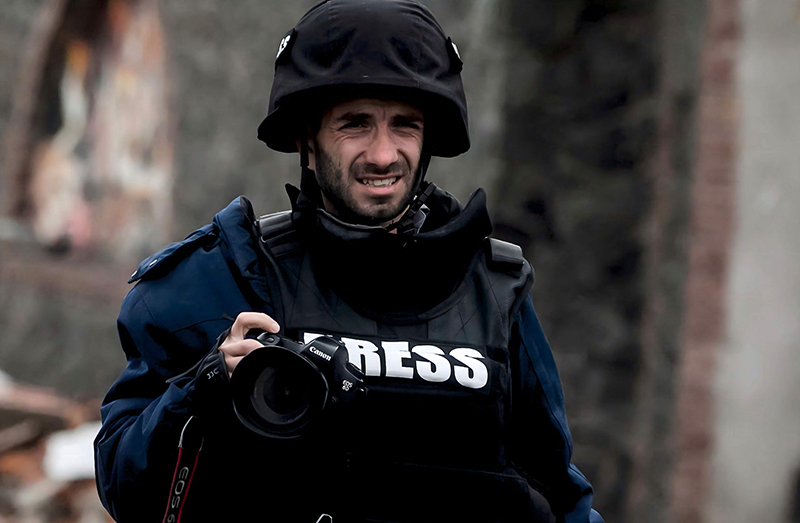
“I am taking part in Ukraine’s fight for freedom,” shares the photographer. “Some people believe that photography is not a significant part of the struggle. However, while now the most crucial thing is sitting in the trenches, in the future, people will learn about this reality from pictures.”
One of his photographs became world famous. He photographed a house in Dnipro bombed by the Russian army. The rocket shattered the wall of a high-rise apartment building, exposing the interior of an apartment. The scene was unsettling: orange kitchen cabinets, apples on the table, and chairs, all surrounded by the aftermath of criminal gunfire. Mikhail Koranovsky, an honored boxing coach of Ukraine, lived in this apartment. He died, leaving a wife and two daughters.

The next photo portrait was taken by Serhii Nuzhnenko from the Ukrainian chapter of RFE/RL. He stood on the infamous street in Bucha, where a column of Russian equipment had been destroyed. The Russian army occupied the city a few days later and committed terrible crimes.
“On February 27, I saw a video on Telegram showing a destroyed column of Russian equipment in Bucha,” said the photojournalist about his trip. “My colleagues informed me of possible routes to the town, and on March 1st, we went there. Everyone was confused, no one understood what was happening or what to expect. It was two days before the occupation of the town. I wonder if the people I urged to evacuate are still alive. They assured me everything would be okay.”

Чым не новы сімвал для гісторыі?
That could be a new historical symbol, couldn’t it?
Efrem Lukatsky is a veteran journalist who has worked extensively in hot spots well before the war in Ukraine. From the late 1980s, he headed the Associated Press’ local office photo service. He captured the historic moment of bringing the national flag to the Verkhovna Rada in 1991. Later he worked as a war correspondent in Afghanistan, Iraq, Chechnya, and Georgia. He now had to document such occurrences in his home country.
The photo taken after the liberation of Kherson captures the emotions of the city’s residents. They are seen smiling, kissing, and celebrating the arrival of the long-awaited liberators. That could be a new historical symbol, couldn’t it?

Spouses Kostiantyn and Vlada Liberov took a series of impressive photos from Kharkiv, Bakhmut, and Kherson, signed Likbos. This is another indication of Russian aggression against Ukrainians. Before the war, the couple was professionally engaged in photographing weddings. Now they cover the effects of the war. Their pictures are used on social media by Volodymyr Zelenskyi, the Ukrainian Ministry of Defense, and Western editorials. The military invited the photographers to visit the dugouts and capture their everyday lives. The Liberovs are still photographing weddings, but on special occasions only.
“If a military man sends us a text saying ‘I’m getting married, come,’ we drop everything and go at our own expense. These are the only weddings we shoot. We’ve given up on civilians for now,” Kostiantyn and Vlada explain.
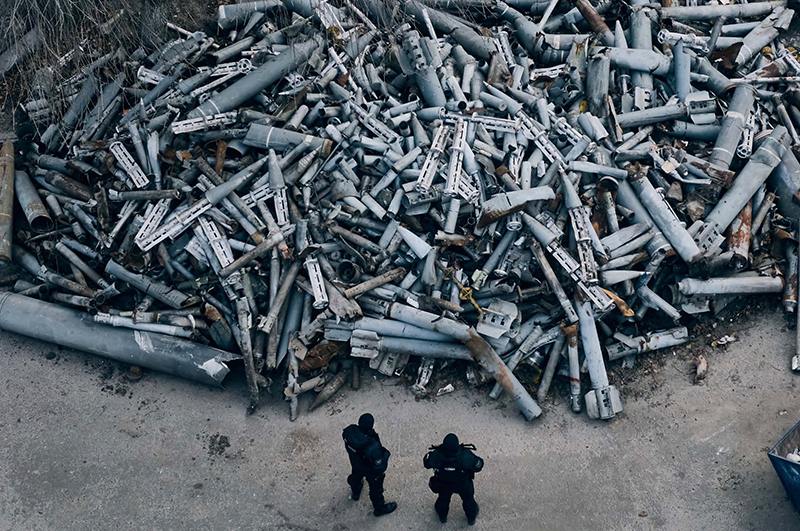
When going on another trip, they prepare for the possibility that they will need to return, process the photos, and share them with the world.
During the opening of the exhibition, Viktor Hamotskyi, the representative of the Embassy of Ukraine in Lithuania, stated the following:
“I am grateful to those who came up with the idea for this exhibit. In my opinion, it has three missions. The first is to honor my country, my people who are heroically fighting for our common freedom. The second is to remind us that the war continues. Third, to realize how important the role of professional and courageous journalism is. Victory over a common enemy will be a shared one!”

Waist deep in water and under fire
Working in a war zone is a constant risk for journalists. There is an opinion that the Russian army is purposefully hunting media representatives. In 2023, two media workers (Bohdan Bitik and Arman Soldin) died in Ukraine, according to Reporters Without Borders. However, there could have been many more journalist casualties.
A case in point: reporters from the Swedish channel TV4 were in eastern Ukraine to cover the counter-offensive. They were getting out of their car when it was hit by a kamikaze drone. Reporter Johan Fredriksson and photographer Daniel Zdolsek were unhurt, but local journalist Oleksandr Pavlov, who was accompanying his colleagues, was slightly injured. He was given medical attention. He also took pictures of the blown-up crossover.
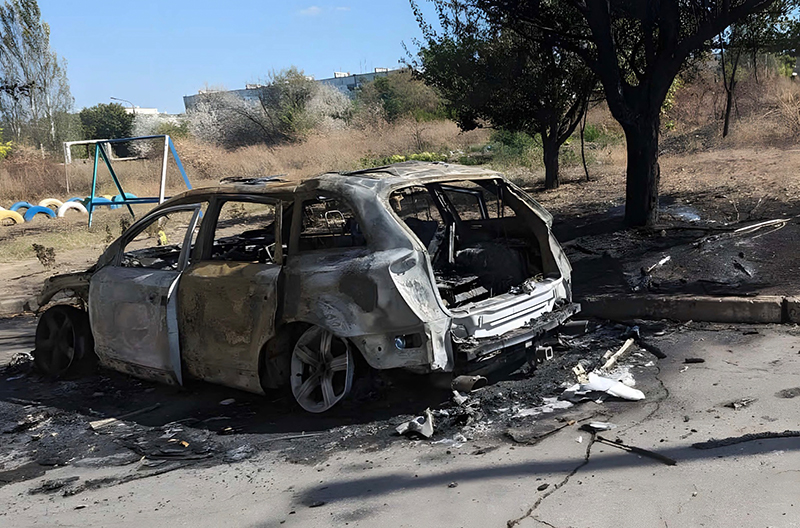
However, it is not only mines and missiles that pose a danger to our colleagues in Ukraine. It is no exaggeration to say that after the destruction of the Kakhovka Dam, journalists had to work in water up to their waists. At that moment they were the eyes of the civilized world. It is no secret that open-source data often becomes evidence of crimes against humanity.
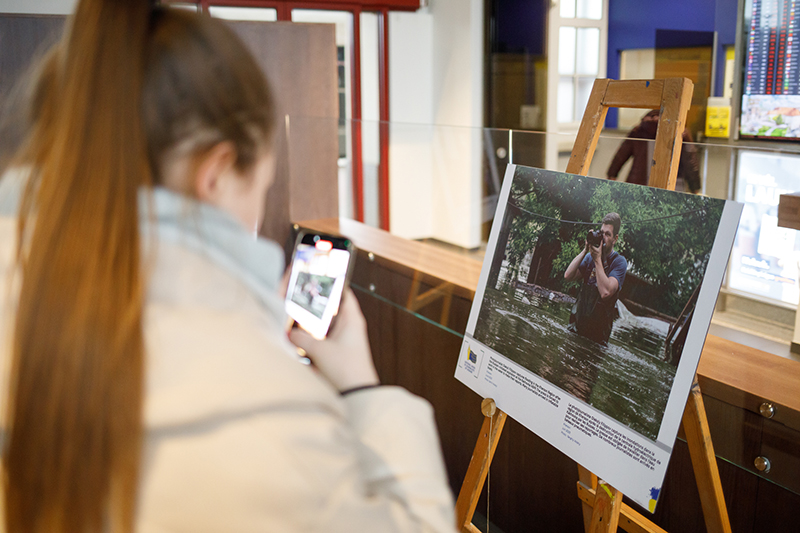
Sergiy Tamilenko, head of the National Union of Journalists of Ukraine (NUJU), delivered a speech to conclude the opening ceremony. He lives in Kyiv, and his words seem particularly relevant:
“The thousands and thousands of people who will pass through the Vilnius train station hall will be able to see the horrors of war and also reflect on the costs, risks, and dangers that journalists in Ukraine face daily. We are tired of war. Unfortunately, we cannot simply turn off the terrible news. Evil and aggression await those who refuse to accept this unjust war. We can’t afford it…”

The exhibition “Ukraine: Journalists in the War Zone” opened on February 24 and will run for two weeks. Admission is free of charge. The exposition is located on the right wing of Vilnius Railway Station.
The Belarusian Association of Journalists and the Lithuanian Union of Journalists invite colleagues and compatriots to visit the exhibition.

Read more:
Journalists in the War Zone: BAJ and LUJ will open an exhibition in Vilnius
Fact-checking Rimas Bružas’ column on LRT: 2% real vs 50% claimed
Malanka Media head’s case submitted to court
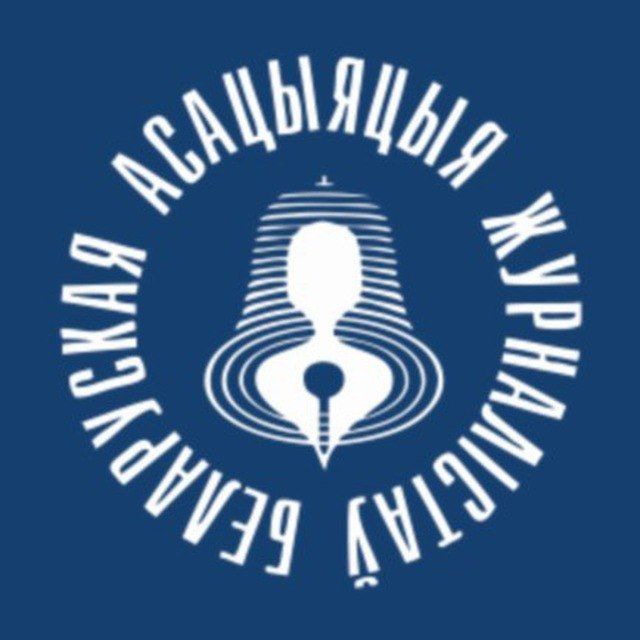 @bajmedia
@bajmedia
